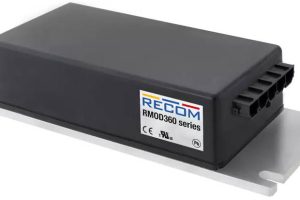
All of the 20A output models, called i7A48020A033V, can operate from inputs across 28 to 60V and deliver an adjustable 3.3 to 32V – output voltage range is restricted at some input voltages, and set by an external resistor.
Efficiency is up to 96%, and maximum output power depends on available cooling. Ambient air limits are -40 to +125°C.
There are seven of them, with the same power section and 34 x 36.8mm footprint, differing only in their interfaces and heat sinking – identification is by numbered suffix.
Six require the on/off pin to be grounded to operate (‘negative remote on/off logic’, in TDK speak), and come in open-frame (11.5mm tall, 25g mass), finned-heatsink (24.9mm, 70g) or baseplate-cooled (12.7mm, 50g) versions, with or without a resistor-adjustable current limit.
The seventh has ‘positive’ remote on/off logic and only comes in the open-frame version without adjustable current limit.
“The 20A i7A models can be used to derive additional high-power outputs at higher efficiency than isolated DC-DC converters,” according to the company. “These compact products are suited for use in mobile robotics, drones, medical, industrial, test, measurement, communications, computing and portable equipment.”
Safety certification is to IEC/UL/CSA/EN 62368-1 standards, and they are CE and UKCA marked for the Low Voltage and RoHS Directives.
Find the i7A data sheet here, and catalogue page contains part number and other useful information.
 Electronics Weekly Electronics Design & Components Tech News
Electronics Weekly Electronics Design & Components Tech News



